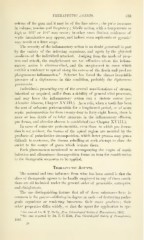Page 435 - My FlipBook
P. 435
THERAPEUTIC AGENTS. 433
oedema of the gum and it may be of the face arises ; tlie pulse increases
in volume, tension and frequency ; febrile action, with a temperature as
high as 103° or 104° may occur ; in other cases distinct evidences of
septic intoxication may appear, and indeed even septicemia or pyemia ^
may result at a later stage.
The severity of the inflammatory action is no doubt governed in part
by the variety of the infecting organisms, and again by the physical
condition of the individual attacked. Judging from the mode of prog-
ress and attack, the staphylococci are the offenders where the inflam-
matory action is circumscribed, and the streptococci in cases which
exhibit a tendency to spread along the course of the fascia and produce
phlegmonous inflammation.^ Schreier has found the almost invariable
presence of a diplococcus in this condition, probably the diplococcus
pneumonice.
Individuals presenting any of the several manifestations of struma,
inherited or acquired, suffer from a debility of general vital processes,
and may have the inflammatory action run a riotous course (see
Alveolar Abscess, Chapter XVIII.). As a rule, when a tooth has been
the seat of subacute pericementitis for a lengthened period, or of acute
septic pericementitis for from twenty-four to forty-eight hours, there is
more or less death of cellular elements in the inflammatory effusion,
pus forms, and alveolar abscess is established (see Chapter XVIII.).
In cases of subacute pericementitis, even those in which pus forma-
tion is not evident, the tissues of the apical region are assailed by the
products of putrefactive decomposition, which latter process may prove
difficult to overcome, the tissues rebelling at each attempt to close the
outlet to the escape of gases Avhich irritate them.
Each phenomenon mentioned as accompanying the stages of septic
infection and albuminous decomposition forms an item for consideration
in the therapeutic measures to be applied.
Therapeutic Agents.
The natural and true inference from w4iat has been stated is that the
class of therapeutic agents to be locally employed in any of these condi-
tions are all included under the general order of germicides, antisejitics,
and disinfedaiifs.
The one distinguishing feature that all of these substances have in
common is the power—differing in degree in each—of destroying patho-
genic organisms or rendering innocuous their waste products ; their
other properties differ widely, so that the agent for application to spe-
^ See case of Dr. E. T. Darby, Proc. Odontological Society of Pennsylvania, 1892.
^ See case reported by Dr. E. C. Kirk, Proc. Odontological Society of Pennsylvania,
1892.
28


